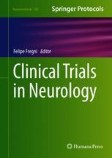Search
Search Results
-
An Investigation into the Factors Governing Drug Absorption and Food Effect Prediction Based on Data Mining Methodology
Drug absorption is a complex process governed by a number of interrelated physicochemical, biopharmaceutical, and pharmacokinetic factors. In order...

-
Antiepileptic Drugs in Pediatrics
Epilepsy affects approximately 1% of the population. First-line treatment for epilepsy is the administration of anti-seizure medication, also...
-
Nose to Brain Drug Delivery for the Treatment of Epilepsy
Drug delivery is basically the process of transferring a drug entity or formulation to the desired target following administration via various routes...
-
Tolerability of new antiepileptic drugs: a network meta-analysis
ObjectiveThe objective of this study was to perform a comparative assessment of tolerability of all licensed new antiepileptic drugs (AEDs) through a...

-
Safety aspects of antiepileptic drugs—a population-based study of adverse effects relative to changes in utilisation
PurposeAntiepileptic drugs (AEDs) are increasingly used, and knowledge about adverse effects is scarce based on clinical studies. The purpose of the...

-
Therapeutic approaches in Congenital Disorders of Glycosylation (CDG) involving N-linked glycosylation: an update
Congenital disorders of glycosylation (CDG) are a group of clinically and genetically heterogeneous metabolic disorders. Over 150 CDG types have been...

-
Lacosamide in patients with intellectual disability and refractory epilepsy
The objective of this study was to evaluate the tolerability and efficacy of lacosamide (LCM) in residential patients at our epilepsy centre. We...

-
The Pharmacology and Toxicology of Third-Generation Anticonvulsant Drugs
Epilepsy is a neurologic disorder affecting approximately 50 million people worldwide, or about 0.7% of the population [
1 ]. Thus, the use of... -
Brivaracetam, but not ethosuximide, reverses memory impairments in an Alzheimer’s disease mouse model
IntroductionRecent studies have shown that several strains of transgenic Alzheimer’s disease (AD) mice overexpressing the amyloid precursor protein...

-
A comparison of new drugs approved by the FDA, the EMA, and Swissmedic: an assessment of the international harmonization of drugs
IntroductionThis study compared the characteristics of new human drugs approved by the Food and Drug Administration (FDA), the European Medicine...

-
Are innovation and new technologies in precision medicine paving a new era in patients centric care?
Healthcare is undergoing a transformation, and it is imperative to leverage new technologies to generate new data and support the advent of precision...

-
In Silico Prediction of Major Clearance Pathways of Drugs among 9 Routes with Two-Step Support Vector MachinesPurposeThe clearance pathways of drugs are critical elements for understanding the pharmacokinetics of drugs. We previously developed in silico ...

-

-
Validation of a Preclinical Drug Screening Platform for Pharmacoresistant Epilepsy
The successful identification of promising investigational therapies for the treatment of epilepsy can be credited to the use of numerous animal...

-
Lijst van Geneesmiddelen
Radiofarmacon dat zich met hoge affiniteit bindt aan het presynaptische dopaminetransporteiwit en in veel mindere mate aan het...
-

-
Breaking Bad: the Structure and Function of the Blood-Brain Barrier in Epilepsy
Epilepsy is a neurological disease with variable etiology and clinical manifestation, affecting more than 50 million people worldwide. Although the...

-
Epilepsy
The aim of this chapter is to help investigators design interventional clinical trials in epilepsy, by reviewing and analyzing the top cited articles...
-
Novel Molecular Targets for Drug-Treatment of Epilepsy
Nowadays several antiepileptic drugs (AEDs) are available for the treatment of patients with epilepsy. Nevertheless, up to 30 % of patients continue...
